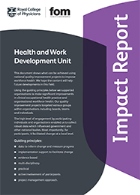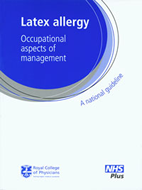HWDU Publications
The Health and Work Development Unit (previously known as the Occupational Health Clinical Effectiveness Unit), was a partnership between the Faculty of Occupational Medicine and the Royal College of Physicians (RCP). The unit closed in August 2014.
The unit leaves a legacy of improvement to health at work, including:
- a series of clinical guidelines relevant to health and work
- a series of concise guidance for all clinicians on occupational health topics
- improvements in occupational health clinical care achieved through its programme of national clinical audits
- a bespoke client experience survey for OH services
- greater implementation of NICE public health workplace guidance in the NHS achieved through its national organisational audit and implementation workshops
The Unit published the following, which are available on-line:
This document shows what can be achieved using national quality improvement projects to improve workforce health. The report draws together all outputs from the Health and Work Development Unit.
Clinical guidelines relevant to health and work
Varicella zoster virus: Occupational aspects of management 2010
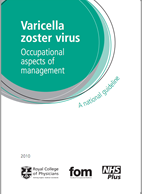 This guideline focuses on managing varicella zoster virus (chicken pox and shingles) in the workplace, providing evidence-based guidance for occupational health professionals. Separate summary leaflets provide advice to employees and employers dealing with varicella zoster virus in the workplace, with specific advice for those in the healthcare sector.
This guideline focuses on managing varicella zoster virus (chicken pox and shingles) in the workplace, providing evidence-based guidance for occupational health professionals. Separate summary leaflets provide advice to employees and employers dealing with varicella zoster virus in the workplace, with specific advice for those in the healthcare sector.
The guideline is accompanied by summary leaflets for employers in the healthcare sector, employees in the healthcare sector, health care professionals and for employees and employers excluding the healthcare sector and on vaccination for healthcare workers.
Upper Limb Disorders: Occupational aspects of management 2009
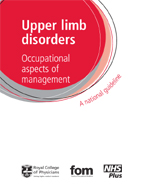 The term ‘upper limb disorders’ covers a large number of musculoskeletal conditions that affect the shoulder, elbow, forearm, wrist or hand. This national guideline offers evidence-based advice on the management of four upper limb disorders in the workplace: carpal tunnel syndrome, non-specific arm pain, tenosynovitis and lateral epicondylitis (tennis elbow).
The term ‘upper limb disorders’ covers a large number of musculoskeletal conditions that affect the shoulder, elbow, forearm, wrist or hand. This national guideline offers evidence-based advice on the management of four upper limb disorders in the workplace: carpal tunnel syndrome, non-specific arm pain, tenosynovitis and lateral epicondylitis (tennis elbow).
The guideline is accompanied by summary leaflets for employers, employees and health care professionals.
Dermatitis: Occupational aspects of management 2009
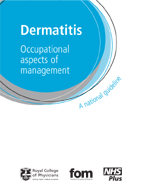 This national guideline offers evidence-based advice on the management of dermatitis in the workplace. It provides advice on the risk of colonisation and transmission of infection from skin lesions, interventions to improve the condition of the skin, and workplace-based health surveillance for the early detection of symptoms and signs.
This national guideline offers evidence-based advice on the management of dermatitis in the workplace. It provides advice on the risk of colonisation and transmission of infection from skin lesions, interventions to improve the condition of the skin, and workplace-based health surveillance for the early detection of symptoms and signs.
The guideline is accompanied by summary leaflets for employers, employees and health care professionals.
Latex Allergy: Occupational aspects of management 2008
This national guideline summarises current evidence and is intended to assist occupational health professionals, managers and other interested parties in providing advice on occupational health interventions and to address the problem of latex allergy from both individual and institutional perspectives. The evidence based guideline is concerned particularly with issues relating to gloves, as these represent the main occupational use of latex.
The guideline is accompanied by summary leaflets for employers, employees and health care professionals.
Physical and Shift Work in Pregnancy: Occupational aspects of management 2009
 The purpose of this national guideline is to enable consistent evidence-based advice to be given in relation to pregnant women who are exposed to hazards at work. The document is focused on a number of specific hazards, namely lifting/manual handling and heavy physical work, prolonged standing, long working hours and shift work (including night shifts). Recommendations have been made for employers to reduce exposure to lifting, heavy physical work and prolonged standing for pregnant employees. None of the risks were sufficiently strong to justify mandatory exclusion of pregnant women from work for any of the exposures that were considered.
The purpose of this national guideline is to enable consistent evidence-based advice to be given in relation to pregnant women who are exposed to hazards at work. The document is focused on a number of specific hazards, namely lifting/manual handling and heavy physical work, prolonged standing, long working hours and shift work (including night shifts). Recommendations have been made for employers to reduce exposure to lifting, heavy physical work and prolonged standing for pregnant employees. None of the risks were sufficiently strong to justify mandatory exclusion of pregnant women from work for any of the exposures that were considered.
The guideline is accompanied by summary leaflets for employers, employees and health care professionals.
Concise guidance on occupational health topics
Diagnosis, management and prevention of occupational contact dermatitis 2011
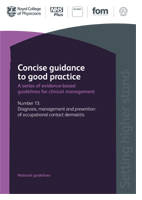 This concise guidance to good practice is Number 13 in a series of evidence-based guidelines for clinical management. It aims to provide physicians who work in primary and secondary medical care with a standardised approach to managing CD in patients of working age.
This concise guidance to good practice is Number 13 in a series of evidence-based guidelines for clinical management. It aims to provide physicians who work in primary and secondary medical care with a standardised approach to managing CD in patients of working age.
The document summarises three key sets of recently published or updated guidance and covers both the clinical and the occupational aspects of case management.
Pregnancy: Occupational aspects of management 2013
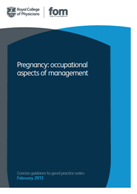 This concise guideline follows an extensive and systematic review of the evidence of certain common work activities (heavy physical effort and lifting, prolonged standing, working long hours and shift working) to see whether these might adversely affect pregnancy outcomes (e.g. miscarriage, pre-term delivery, delivering a small-for-dates baby).
This concise guideline follows an extensive and systematic review of the evidence of certain common work activities (heavy physical effort and lifting, prolonged standing, working long hours and shift working) to see whether these might adversely affect pregnancy outcomes (e.g. miscarriage, pre-term delivery, delivering a small-for-dates baby).
The guideline is accompanied by summary leaflets on heavy lifting, shiftwork, heavy physical work, standing and long working hours.
Diagnosis, management and prevention of occupational asthma 2012
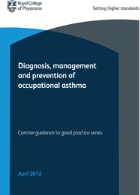 This concise guideline, aimed at physicians, summarises a full guideline published in 2010 by the British Occupational Health Research Foundation and aims to help reduce the severity of individual cases of occupational asthma by promoting earlier, accurate identification and better management.
This concise guideline, aimed at physicians, summarises a full guideline published in 2010 by the British Occupational Health Research Foundation and aims to help reduce the severity of individual cases of occupational asthma by promoting earlier, accurate identification and better management.
Completion of the Statement of Fitness for Work 2012
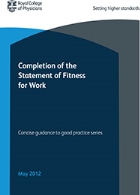 This concise guideline has been developed to aid doctors in understanding when and how to issue a fit note to the greatest benefit for their patients.
This concise guideline has been developed to aid doctors in understanding when and how to issue a fit note to the greatest benefit for their patients.
National clinical audits on occupational health
Back pain management audit 2009 – round 1
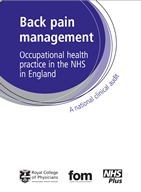 This national comparative clinical audit measures how well occupational health doctors and nurses are managing NHS staff in England with back pain, a frequent and a major cause of sickness absence. Occupational health professionals should follow the FOM Guidelines for the management of low back pain. We therefore used the standards contained in these guidelines to develop auditable criteria against which the care provided by occupational health doctors and nurses could be measured.
This national comparative clinical audit measures how well occupational health doctors and nurses are managing NHS staff in England with back pain, a frequent and a major cause of sickness absence. Occupational health professionals should follow the FOM Guidelines for the management of low back pain. We therefore used the standards contained in these guidelines to develop auditable criteria against which the care provided by occupational health doctors and nurses could be measured.
Back pain management audit 2012 – round 2
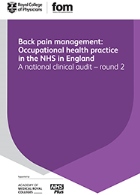 This second round national clinical audit sought to measure how well occupational health (OH) clinicians and services in all industries throughout the UK are managing staff with back pain, and if there had been any change since the first audit round.
This second round national clinical audit sought to measure how well occupational health (OH) clinicians and services in all industries throughout the UK are managing staff with back pain, and if there had been any change since the first audit round.
The project later formed part of the National Quality Improvement Programme (NQIP) and was available to all OH services in the UK from January 2014.
Long-term sickness absence and depression detection 2009 – round 1
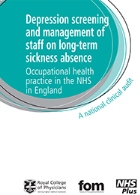 This national clinical audit measures how well occupational health professionals are assessing and managing depression in NHS staff on long-term sickness absence. The aim of the audit is to raise the standard of occupational health care by evaluating performance against evidence-based best practice, working with occupational health practitioners to plan targeted quality improvement interventions and developing the tools to support these interventions.
This national clinical audit measures how well occupational health professionals are assessing and managing depression in NHS staff on long-term sickness absence. The aim of the audit is to raise the standard of occupational health care by evaluating performance against evidence-based best practice, working with occupational health practitioners to plan targeted quality improvement interventions and developing the tools to support these interventions.
Long-term sickness absence and depression detection 2010 – round 2
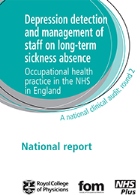 This second round national comparative clinical audit measured change in how well occupational health (OH) professionals were detecting and managing depression in long‐term sickness absence cases and implementing the long‐term sickness absence guidance since the first audit round.
This second round national comparative clinical audit measured change in how well occupational health (OH) professionals were detecting and managing depression in long‐term sickness absence cases and implementing the long‐term sickness absence guidance since the first audit round.
The audit subsequently formed part of the National Quality Improvement Programme (NQIP) and was available to all OH services in the UK from August 2013.
Record keeping audit 2012 – round 1
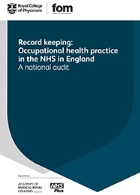 The aim of this national audit was to assess variations in practice with respect to clinical record keeping in OH departments that serve NHS trusts in England. It enabled OH departments to compare the quality of their OH record keeping with national standards and other services providing to the NHS. .
The aim of this national audit was to assess variations in practice with respect to clinical record keeping in OH departments that serve NHS trusts in England. It enabled OH departments to compare the quality of their OH record keeping with national standards and other services providing to the NHS. .
The audit subsequently formed part of the National Quality Improvement Programme (NQIP) and was available to all OH services in the UK from August 2013.
Client experience survey for OH
Client experience survey 2012 – round 1
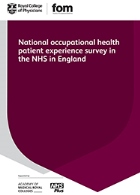 The survey aimed to assess variations in client satisfaction with their employer’s occupational health (OH) service, and enabled OH services to benchmark the care provided to their staff against other OH services. It also aimed to compare the results, where possible, against previous participation and a national benchmark.
The survey aimed to assess variations in client satisfaction with their employer’s occupational health (OH) service, and enabled OH services to benchmark the care provided to their staff against other OH services. It also aimed to compare the results, where possible, against previous participation and a national benchmark.
The survey subsequently formed part of the National Quality Improvement Programme (NQIP) and was available to all OH services in the UK from January 2014.
Public health audits and implementation support
Implementing NICE public health guidance for the workplace 2011 – round 1
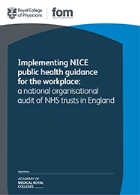 This report is a part of the first national audit that examines the implementation of six pieces of National Institute for Health and Clinical Excellence (NICE) public health guidance relevant to the workplace, by NHS trusts in England. The public health guidance covers obesity, promoting physical activity, long-term sickness absence, promoting mental health and smoking cessation.
This report is a part of the first national audit that examines the implementation of six pieces of National Institute for Health and Clinical Excellence (NICE) public health guidance relevant to the workplace, by NHS trusts in England. The public health guidance covers obesity, promoting physical activity, long-term sickness absence, promoting mental health and smoking cessation.
It supports trusts to improve staff health and wellbeing in areas which are known to be cost effective, contributing to increasing productivity and reducing costs.
Implementing NICE public health guidance for the workplace: overcoming barriers and sharing success 2012
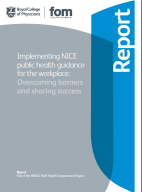 This report reviews the extent to which NHS Trusts are implementing NICE guidance on improving staff health and wellbeing. Aimed at Boards and others with leading roles in Trusts, this report examines the barriers and enablers with a view to supporting those who are implementing, or reviewing and revitalising, their staff health agenda.
This report reviews the extent to which NHS Trusts are implementing NICE guidance on improving staff health and wellbeing. Aimed at Boards and others with leading roles in Trusts, this report examines the barriers and enablers with a view to supporting those who are implementing, or reviewing and revitalising, their staff health agenda.
Implementing NICE public health guidance for the workplace 2013 – round 2
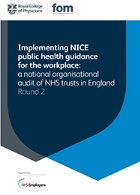 This second round audit report examines progress made with the implementation of six pieces of National Institute for Health and Clinical Excellence (NICE) public health guidance relevant to the workplace by NHS trusts in England.
This second round audit report examines progress made with the implementation of six pieces of National Institute for Health and Clinical Excellence (NICE) public health guidance relevant to the workplace by NHS trusts in England.
Workplace economic models: the costs and benefits to employers
Download – This document is an Excel spreadsheet designed to help NHS employers to estimate the costs and savings associated with providing health promotion services for their employees. It brings together estimates for workplace health promotion activities recommended by the National Institute for Health and Care Excellence (NICE):
- Workplace interventions to promote smoking cessation (PH5)
- Promoting physical activity in the workplace (PH13)
- Managing long-term sickness and incapacity for work (PH19)
- Promoting mental wellbeing at work (PH22)
- Obesity: Guidance on the prevention, identification, assessment and management of overweight and obesity (CG43)



